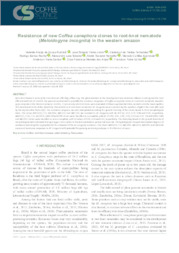Resistance of new Coffea canephora clones to root-knot nematode (Meloidogyne incognita) in the western amazon.
Resistance of new Coffea canephora clones to root-knot nematode (Meloidogyne incognita) in the western amazon.
Autoria: RUDNICK, V. A. de S.; VIEIRA JÚNIOR, J. R.; FERNANDES, C. de F.; ROCHA, R. B.; TEIXEIRA, A. L.; RAMALHO, A. R.; ESPINDULA, M. C.; SANTOS, A. V.; ANJOS, E. F. M. dos; UCHÔA, F. P.
Resumo: Root-knot disease is among the main diseases affecting coffee crop. The plant selection to the development new resistant cultivars is among one the most efficient methods of control. The present work aimed to quantify the resistance responses of Coffea canephora clones to root-knot nematode Meloidogyne incognita in the Western Amazon. For this, 17 previously selected clones were evaluated in three experimental trials, carried out in the municipalities of Ji-Paraná and Porto Velho, Rondônia. The resistance to root-knot nematodes M. incognita were evaluated by the numbers of gall in the roots (NG) and by the reproductive factor (RF). The resistance response was also interpreted according the genetic diversity of the clones based in their morphological traits. The clones BRS3210, C12, BRS2314, BRS3137 and BRS1216 are resistant to M. incognita with RF of 0.34, 0.62, 0.79, 0.86 and 0.98, respectively. BRS3213, C125, C15, BRS2336, BRS3220 and C09 clones were classified as susceptible, with RF of 1.93, 1.95, 2.00, 2.31, 2.32 and 2.35. The BRS3193, C160 and BRS2357 clones were classified as very susceptible, with RF values of 3.03, 4.41 and 5.82, respectively. The clustering based on the genetic diversity of morphological traits indicated that genotypes more similar to the Robusta botanic variety had lower RF. The hybrid plants showed intermediate degrees of resistance indicating the segregation for the character of the M. incognita resistance. The clones BRS3210, C12, BRS2299, BRS2314, BRS3137 and BRS1216 expressed resistance responses to M. incognita with potential for growing resistant genotypes in the Western Amazon.
Ano de publicação: 2020
Tipo de publicação: Artigo de periódico
Unidade: Embrapa Agroindústria Tropical
Palavras-chave: Amazônia Ocidental, Café, Coffea Canephora, Comportamento de Variedade, Disease resistance, Doença de Planta, Ji-Paraná (RO), Melhoramento Genético Vegetal, Meloidogyne Incognita, Nematóide, Nó da raiz, Plant breeding, Porto Velho (RO), Resistência Genética, Rondônia, Root diseases, Root-knot nematodes, Variety trials, Western Amazon
Observações
1 - Por padrão são exibidas publicações dos últimos 20 anos. Para encontrar publicações mais antigas, configure o filtro ano de publicação, colocando o ano a partir do qual você deseja encontrar publicações. O filtro está na coluna da esquerda na busca acima.
2 - Para ler algumas publicações da Embrapa (apenas as que estão em formato ePub), é necessário ter, no celular ou computador, um desses softwares gratuitos. Sistemas Android: Google Play Livros; IOS: iBooks; Windows e Linux: software Calibre.
Acesse outras publicações
Acesse a Base de Dados da Pesquisa Agropecuária (BDPA) para consultar o acervo completo das bibliotecas da Embrapa.

